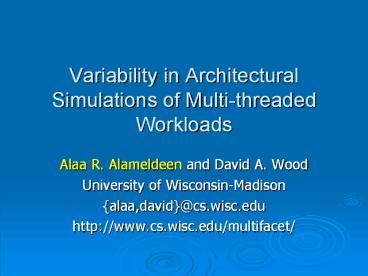Variability in Architectural Simulations of Multi-threaded Workloads - PowerPoint PPT Presentation
Title:
Variability in Architectural Simulations of Multi-threaded Workloads
Description:
Variability in Architectural Simulations of Multi-threaded Workloads Alaa R. Alameldeen and David A. Wood University of Wisconsin-Madison {alaa,david}_at_cs.wisc.edu – PowerPoint PPT presentation
Number of Views:123
Avg rating:3.0/5.0
Title: Variability in Architectural Simulations of Multi-threaded Workloads
1
Variability in Architectural Simulations of
Multi-threaded Workloads
- Alaa R. Alameldeen and David A. Wood
- University of Wisconsin-Madison
- alaa,david_at_cs.wisc.edu
- http//www.cs.wisc.edu/multifacet/
2
Motivation
- Experimental scientists use statistics
- Computer architects in simulation experiments
dont! - Why ignore statistics?
- Simulations are deterministic
- This can lead to wrong conclusions!
3
Workload Variability
OLTP
4
Workload Variability
OLTP
5
What Went Wrong?
- Many possible executions for each configuration
- Why? Different timing effects
- OS scheduling decisions
- Different orders of lock acquisition
- Different transaction mixes
- This is magnified by short simulations
- Variability can lead to wrong conclusions
6
Overview
- Variability is a real phenomenon for
multi-threaded workloads - Runs from same initial state can be different
- Variability is a challenge for simulations
- Simulations are short
- Our solution accounts for variability
- Multiple runs, statistical techniques
7
Outline
- Motivation and Overview
- Variability in Real Systems
- Time and Space Variability
- Variability in Simulations
- Accounting for Variability
- Conclusions
8
What is Variability?
- Differences between multiple estimates of a
workloads performance - Time Variability
- Performance changes during different phases of a
single run - Space Variability
- Runs starting from the same state follow
different execution paths
9
Time Variability in Real Systems
One-second intervals
OLTP
10
Time Variability Example (Contd)
- How is this handled in real experiments?
- Solution Run your experiment long enough!
One-minute intervals
OLTP
11
Space Variability in Real Systems
One-second averages 5 runs
OLTP
12
Space Variability Example (Contd)
- How is this handled in real experiments?
- Same Solution Run your experiment long enough!
16-day simulation
One-minute averages 5 runs
OLTP
13
Outline
- Motivation and Overview
- Variability in Real Systems
- Variability in Simulations
- Simulation Infrastructure
- Injecting Randomness
- The Wrong Conclusion Ratio
- Accounting for Variability
- Conclusions
14
Simulation Infrastructure
- Workloads
- Two scientific and five commercial benchmarks
- Target System E10000-like 16-node system
- Full System Simulation
- Virtutech Simics running Solaris 8 on SPARC V9
- A blocking processor model (Simics)
- An OoO processor model (TFSim Mauer et al.,
SIGMETRICS02) - Memory system simulator
- MOSI invalidation-based broadcast coherence
protocol (Martin et al., HPCA-02)
15
Simulating Space Variability?
- Simulations are deterministic
- Variability cannot be ignored for multi-threaded
applications - One execution may not be representative
- Execution paths affect simulation conclusions
- We need to obtain a space of results
16
Injecting Randomness
- We introduce artificial random perturbations in
each simulation run - For each memory access, latency in nanoseconds
becomes Latency r - (r -2, -1, 0, 1, 2 nanoseconds, uniform dist.)
- Roughly models contention due to DMA traffic
- Other methods are possible
17
Simulated Space Variability
20 runs 10 hrs sim.
- Space variability exists in our benchmarks
18
Quantifying Variability The Wrong Conclusion
Ratio (WCR)
20 runs 50 Xacts
OLTP
- WCR (16,32) 18
- WCR (16,64) 7.5
- WCR (32,64) 26
19
Outline
- Motivation and Overview
- Variability in Real Systems
- Variability in Simulations
- Accounting for Variability
- Conclusions
20
Confidence Intervals
- Definition
- Range of values expected to include population
parameter (e.g. mean) - Confidence Probability
- Probability that true mean lies inside confidence
interval - For the same confidence probability
- Sample Size ? ? Confidence Interval ?
21
Accounting for Space Variability
OLTP
22
Accounting for Space Variability
OLTP
- Simple solution Estimate runs such that
confidence intervals do not overlap - Tests of hypotheses can be used (paper)
23
Conclusions
- Short runs of multi-threaded workloads exhibit
variability - Variability can lead to wrong simulation
conclusions - Our Solution
- Injecting randomness
- Multiple runs
- Apply statistical techniques
24
Backup Slides
25
Effects of OS Scheduling
26
WCR Definition
- Percentage of comparison simulation experiments
that reach a wrong conclusion - The correct conclusion is the relationship
between averages of the two populations - WCR can be used to estimate the wrong conclusion
probability for single experiments
27
Confidence Intervals - Equations
- The confidence interval for the mean of a
normally distributed infinite population - Sample Size needed to limit mean relative error
to r
28
Hypothesis Testing
- Tests whether there is no difference between two
population means - Hypothesis µ32 µ64 tests whether the two means
of the 32 and 64 ROB configurations are different - Hypothesis is tested using sample means and
variances - If hypothesis rejected ? Our conclusion is
significant
29
Accounting for Time Variability
- Is time variability caused by the same effects
that cause space variability? - Use Analysis of Variance (ANOVA)
- If time variability is caused by different
effects, we need to obtain a time sample - Observations obtained from different starting
points
30
Multi-threaded Workloads and Simulation
- Multi-threaded workloads are important
- Workloads for commercial servers
- New architectures support multi-threading
- Performance metrics are different from
traditional benchmarks - Throughput-oriented (transactions)
- IPC is not appropriate (idle time!)
- Simulation Challenge Comparing systems running
multi-threaded applications
31
Simulation of Multi-threaded Workloads
- Simulation is slow!
- We cannot simulate the whole workload
- Solution
- Run for a fixed number of transactions
- Measure the per-transaction runtime (cycles per
transaction) - Use to compare different systems































